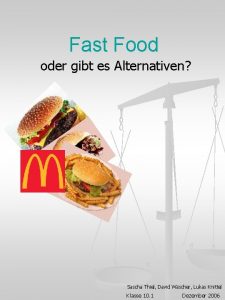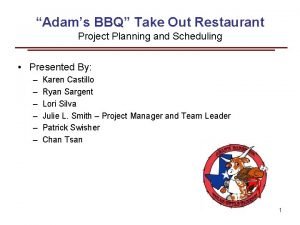College Student Frequency of Restaurant FastFood Consumption and

- Slides: 1

College Student Frequency of Restaurant, Fast-Food Consumption and Impact on Dietary Quality Score Lauren Kieffer, B. S. & Jesse Stabile Morrell, Ph. D Department of Agriculture, Nutrition, and Food Systems University of New Hampshire According to the National Health and Nutrition Examination Survey (NHANES), fast-food and restaurant consumption is the highest among young adults than any other age group. 1, 2 Despite the evidence on the implications of fast-food on diet quality, fast-food consumption and dietary implications are overlooked in this population. 3 Studies have shown that among the factors influencing dietary choices in college students, convenience tends to be one of three the highest ranked reasons for selected food choices. 4 Due to the busy schedule of college students, this population is more susceptible to making food choices based on convenience. Additional barriers to college students consuming healthy diets are snacking as well as the abundance of high-calorie convenience food, the price of healthy food, and stress. 4 Objective To assess the differences in dietary quality of undergraduate college students according to their frequency of consumption of restaurant and fast-food chain (RFF) meals. Methods Study Design: This data is collected from the College Health and Nutrition Assessment Survey, an ongoing, cross-sectional study on the health-status of college students (18 -24 years old) at the University of New Hampshire (UNH IRB # 5524). Participants: Young adults were recruited from an introductory nutrition course between 2005 -2020; all participants provided informed consent to participate, and results from the questionnaire was self-reported. Data Collection: • Restaurant meal, fast-food consumption was determined by the question, “On average, how many times a week do you eat at a restaurant or fast-food chain? ” • Self-reported responses to their weekly frequency of eating meals at a restaurant, fast-food chain were categorized (None, 1 -2, or 3). • Participants also completed 3 -day food records; average daily nutrient intake was computed via online software (Diet. Wellness+). Data Management/Analysis: After stratifying by gender, diet quality was scored by creating quintiles of the average intakes of calcium (mg), potassium (mg), fiber (g), and saturated fat (g); scores (1 -5) for each nutrient were then summed to create a single diet quality score (4 -20). Diet quality scores 13 were defined as healthy. 5 Differences in diet scores between restaurant, fast-food groups were examined via ANCOVA; daily kilocalories, BMI, age, race, gender, and year served as covariates. Acknowledgements Thank you to Dr. Jesse Stabile Morrell for your help and support in this project. Thank you to the NUTR 400 Professor’s and Teaching Assistants for making this research possible. Mean Diet Scores Based on Frequency of Restaurant, Fast-Food Consumption Diet Quality Score Introduction 13 11, 5 10 8, 5 7 5, 5 4 [VALUE] 11, 73 10, 84 None 1 to 2 3 or More Self-reported Weekly Restaurant, Fast-Food Consumption Subject Characteristics Race White (n = 9221) Race Other (n = 565) Gender Women (n = 7162) Men (n = 3136) Age 18 (n = 4634) 19 (n = 3273) 20 -24 (n = 2393) Reported Weekly Restaurant, Fast. Food Consumption 94% 6% 6. 3% 70% 30% 45% 32% 23% 48. 5% None 1 to 2 45. 1% 3 or more Findings & Implications Overall, college students didn’t consume healthy diets and those with greater frequency of restaurant, fast-food meals had lower quality diets. Further, diet quality decreased with increasing frequency of meals at restaurant, fast-food chains. Future research from diverse college campuses will aid in the understanding of how eating at restaurant and fast-food chains impacts dietary quality in the college student population. This knowledge can help tailor and promote nutrition education on college campuses. Department Funding Source New Hampshire Agriculture Experiment Stations and the USDA National Institute of Food and Agriculture Hatch Project. References 1. Fryar CD, Hughes JP, Herrick KA, Ahluwalia N. Fast Food Consumption Among Adults in the United States, 2013 -2016. NCHS Data Brief. 2018; (3222): 1 -8. 2. Laska MN, Hearst MO, Lust K, Lytle LA, Story M. How we eat what we eat: identifying meal routines and practices most strongly associated with healthy and unhealthy dietary factors among young adults. Public Health Nutrition. 2014; 18(12): 2135 -2145. doi: 10. 1017/s 1368980014002717. 3. Winpenny EM, Winkler MR, Stochl J, Sluijs EMFV, Larson N, Neumark-Sztainer D. Associations of early adulthood life transitions with changes in fast food intake: a latent trajectory analysis. International Journal of Behavioral Nutrition and Physical Activity. 2020; 17(1). doi: 10. 1186/s 12966 -020 -01024 -4. 4. Sogari, Giovanni et al. “College Students and Eating Habits: A Study Using an Ecological Model for Healthy Behavior. ” Nutrients vol. 10, 12 1823. 23 Nov. 2018, doi: 10. 3390/nu 10121823 5. Pereira MA, Kartashov AI, Ebbeling CB, et al. Fast-food habits, weight gain, and insulin resistance (the CARDIA study): 15 -year prospective analysis. The Lancet. 2005; 365(9453): 36 -42. doi: 10. 1016/s 0140 -6736(04)17663 -0.

